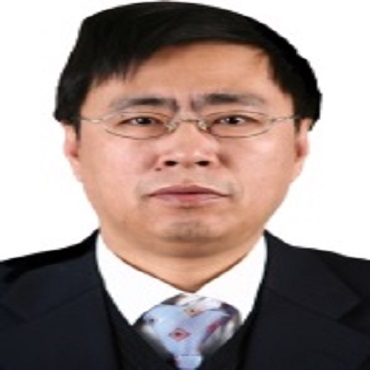Scientific Program
Keynote Session:
Title: Technologies advancement and prospect of natural gas development in China
Biography:
Ailin Jia is an expert of development of natural gas resource. He received his B.S. degree in Petroleum Geology from the China University of Petroleum and his M.S. and Ph.D. degrees in Petroleum Engineering from Research Institute of Petroleum Exploration & Development (RIPED), Beijing, China. In 2005 he became a Professor of Petroleum Engineering at RIPED, PetroChina. From 1992, he has worked in the areas of oil & gas geology, reservoir modeling and engineering. He is currently director of Department of gas field development, RIPED, PetroChina. As a professor, he has published over 80 papers and 10 books in the oil & gas development fields.
Abstract:
In recent years, international oil prices have stayed low and China strives to develop green energy. Under these backgrounds, natural gas has gradually become the key business of petroleum industry in our country. Since the initial of 12th National Five-Year Plan, average reserves of more than 880 billion square are proved annually. After years of hardworking, several developmental technological breakthroughs are achieved for deep gas, tight gas, shale gas, coal-bed methane, development adjustment strategies, engineering technologies and decision-making system. With the depth of development, influenced by policy, environment and geological conditions, continuous efficient development of domestic natural gas faces many challenges: lower ratio of high quality reserves, more development expense, larger difficulties of remaining development benefit for unconventional gas reservoir, further upstream benefit compression, poorer stable production ability and fiercer competition in the energy market. In the future, our natural gas development will enter into the new stage of emphasizing on both the unconventional gas and the conventional gas, natural gas demand and consumption structure will become more diversified, gas imports will rise year by year, resulting in the increased external dependency, and natural gas will become the main growth engine in the process of energy structure adjustment.
Title: Reserves classification and well pattern infilling adjustment in tight sandstone gas field
Biography:
Guo Zhi got his PhD degree at Petrochina Research Institute of Petroleum Exploration and Development in 2014 and has engaged in his career for about 10 years. His major is Oil & Gas development geology. He has made some progress in reservoir description, geology modelling, reserves classification and horizontal well optimization for tight sand gas, publishing more than 10 influential papers both home and aboard.
Abstract:
Sulige gas field is typical of tight sandstone gas field in China. The reservoir property is poor, the effective sand bodies are with small scale, low distribution frequency and strong heterogeneity, and various development blocks differ greatly from others. It is difficult to exploit the reserves effectively relying on the current developing well pattern of 600m×800m, with recovery rate only about 30%. Thus it is necessary to evaluate various types of reserves comprehensively and implement well pattern infilling adjustment respectively. Choosing Su14 block in central Sulige as the study area, through fine reservoir description in dense well pattern and interference well test analysis, the reservoir development frequency and scale was studied. With braided-river sedimentary facies as the constraint, integrating reserves abundance value, reservoir superimposed style, poor gas layers influence and dynamic characterization, reserves of the gas field were classified into five types. From reserve types I to V, reservoir thickness gets thinned, reservoir continuity becomes poorer, reserves grade turns down and well production performance is worse. Compared actual production data with modeling & simulation result, the relation of well pattern density, interference degree and recovery rate was researched for each type of reserves. In the existing economic and technical conditions, the reasonable well pattern density in various type of reserves area is 2~4 wells per square kilometers, and the ultimate recovery rate is about 50%. This research, makes reserves configuration clear in the tight sandstone gas field, provides geological basis for well pattern infilling adjustment in later development stage, lays a solid foundation for long-term stable production of gas field, and is also of certain reference significance to other gas field development under similar geological conditions.
Title: Principles of establishing waste to energy plants in developing countries
Biography:
Abhishek Asthana is the Director of Hallam Energy, the energy research group at Sheffield Hallam University (SHU). In 2009, he co-founded Hallam Energy and has since led and delivered more than 50 projects of industrial energy research, consultancy and knowledge transfer. He has won £3.5 million funding for SHU, co-authored 37 scientific papers and 1 book, invented 4 patents and developed 5 commercial software packages. He is the course director for BEng Energy Engineering and MEng and BEng Chemical Engineering programs at the university. In 2015, he established a Doctoral Training Alliance (DTA) in Energy to train PhD students conducting energy research. The DTA has now grown to 90 PhD students and 180 Supervisors across 19 British Universities in the University Alliance, UK, and Abhishek is currently its Deputy Director. He also recently led the alliance to success in winning €6.5 Million funding from the European Commission’s Marie SkÅ‚odowska-Curie Actions COFUND to further expand the DTA program.
Abstract:
Under the "Clean India Mission", the Ministry of Urban Development (MoUD) of India is investing US$ 9 Billion to clean up 75 largest cities in India. Waste to Energy (WTE) plants will be a key to its implementation. A new state-of-the-art WTE plant in New Delhi is planned for this purpose to set an example for other cities to follow.
Delhi generates 8,400 tons per day (TPD) of Municipal Solid Waste (MSW), which is expected to double in the next 15 years. The current capacity of waste processing plants in Delhi is only 8,000 TPD. It is estimated that by the year 2050, Delhi would require 100 km2 of landfill area, which is 7% of the total land area of the capital for waste disposal unless a new WTE plant is commissioned. The existing landfill sites in Delhi have dangerously exceeded their capacity already.
WTE projects have been running successfully in many countries but have produced only mixed results in India and have often been plagued with controversies. This is due to various technical, financial, environmental, political and social factors involved.
Hallam Energy at Sheffield Hallam University was commissioned by the Government of India, to conduct a detailed independent investigation into the techno-economic feasibility of such a WTE project in Delhi.
The goals of this study were (i) to make an informed decision on whether the proposed WTE facility for Delhi will be technically and financially viable, and (ii) to gain a reasonable understanding of the costs and resources involved in this investment. This work looks at the various challenges associated in setting up WTE plants in developing countries and address key findings including:
1. The capacity of the plant
2. The capital cost
3. The electrical power output
4. Land area requirement
5. Site selection for the plant
6. The choice of processes and pre-processing of the feed
7. Feasibility of trigeneration or CHP
8. Choice of technologies and equipment
9. Financial models
10. Emissions of pollutants
11. Lessons learnt from past WTE projects in India
Title: Renewable energy based cogeneration on the example of micro scale installation with biomassfired boiler and modified Rankine cycle
Biography:
Krzysztof Sornek is a Research Assistant at AGH University of Science and Technology in Krakow, Poland. He holds a MSc. in Energy from Faculty of Energy and Fuels (AGH UST). His research interests includes: renewable energy sources, micro cogeneration technologies, automation in energy systems, and electromobility. He is supervisor of Eco-Energy and AGH Solar Plane student interest groups and AGH Solar Boat project. Moreover, Krzysztof Sornek is President of the Board at the Institute for Sustainable Energy.
Abstract:
Renewable energy based cogeneration systems are an interesting option for different sectors, including e.g. domestic, agricultural, and commercial ones. Among the available renewable sources, biomass is characterized by high caloric value, wide availability, and low prices.
This paper shows the operation parameters of the prototypical micro-CHP system operating according to modified Rankine Cycle and using biomass-fired boiler as a heat source. Steam generated in two shell and tube heat exchangers (evaporator and superheater) is used to power the steam engine (connected with power generator). Another one shell and tube heat exchanger works as condenser. The analyzed micro-CHP system is controlled by the dedicated control and measurement system based on WAGO PFC200 PLC controller. The following parameters are recording: temperature, pressure, medium flow, and medium level (in the boiler, oil circuit, steam-condensate circuit and water circuit) as well as current and voltage given by the power generator. The general view of the micro-CHP installation is shown in Figure 1.
Presented results include: (a) the analysis of the amount of thermal power transferred from flue gas to oil (in the boiler), from oil to water (in the evaporator), and from oil to steam (in the superheater), (b) the analysis of pressure and steam flow variations related to the steam temperature, (c) the analysis of power generation in relation with steam pressure and flow.
Conducted up to now tests allowed to obtain electric power at a level of ~1.05 kWel (compared to 100 kWth of the boiler’s nominal thermal power). Such a low value results from several limitations in actual oil and steam circuits construction (what causes limitations in temperature and steam pressure, and consequently in generated electric power). On the other hand, the expected level of power generated in the system should be 5-10 kWel (after introducing some modifications to the system construction).
Oral Session 1:
- Trends in Renewable Energy, Hybrid Renewable Energy Approaches, Solar, Wind and Marine Energy, Biofuels, Bioenergy and Sustainable Nuclear Energy
Title: Investigation and evaluation of aerodynamic efficiency improvement measures for vertical axis small wind turbines
Biography:
Daniel Lehser-Pfeffermann has studied mechatronics and sensor technology and works since 2014 as a research assistant in the lab of wind energy technologies on the university of applied sciences Saarbrücken. Actually, he worked in the fields of simulation (structural analysis, multi body simulation, computational fluid dynamics) additive manufacturing and experimental investigation. In his PhD-Project, he focused on the development and efficiency upgrade of vertical axis small wind turbines for suburban areas.
Abstract:
Power generation using wind turbines is an essential element of regenerative energy supply. Due to geographical and legal restrictions, multi-megawatt wind turbines are only installed at a considerable distance from consumers. In order to reduce grid losses, small wind turbines are used for local power generation. However, in suburban areas, increased turbulence in the wind conditions must be taken into account due to the development of small wind turbines. Since vertical axis wind turbines (VAWT) operate more independently of the wind direction, they are better suited for such applications despite lower overall power efficiency.
In order to increase the efficiency of VAWTs, various active and passive methods are investigated within the scope of this work. In particular, these are applications for vertex generation, surface layer suction and flexible trailing edges. The influence of the applications on the lift and drag coefficients in comparison to the original NACA 0021 profile is shown by simulative investigations. The flow around the profile is calculated and the resulting lift forces are plotted depending on the angle of attack. To validate the simulation, experimental investigations of the profile applications are carried out in a small wind tunnel. For manufacturing of the profile prototypes, an additive manufacturing process is used.
Finally, the simulation and test results are compared. In addition to the lift to drag ratio, an economic implementation is further evaluation criterion for the possible use on a VAWT rotor.
Title: Experimental and numerical analysis of wind turbines operation- polish case
Biography:
Abstract:
Statement of the problem: Growing demand for energy generated from renewable energy sources is observed worldwide. This fact is caused by many factors especially environmental ones. The sector of renewable energy sources which can be seen the most dynamic development is wind energy. This is caused by the construction of huge wind turbines, whose power exceeds one megawatts. Main problem of wind power systems is location for such turbines. Generally, wind turbines are located on-shore and off-shore. The most favourable are off-shore because of better wind condition what causes bigger power generation. To optimize construction and localization of wind power systems it is significant to analyze meteorological data for minimum 10 years. Furthermore it is necessary to prepare simulation of system operation in proposed location. Software which allows to observe meteorological trends and to simulate operation of energy systems based on wind is TRSNSYS. The study shows TRNSYS model of wind power system located in Poland with its validation. Optimization of the system was also proposed. Some economical parameters of the installation was calculated. Conclusion & Significance: It is possible to predict operation of wind turbines in different locations using numerical models. Profitability of wind farms strongly depends of location.
Title: Selection of batteries and optimatization of energy consumption during AGH solar plane fight
Biography:
Aleksandra Szelag is ambitious student of the 4th year of Power Engineering on AGH UST. At the second year of studies, she joined to SSC Hydrogenium”. During this two years she was analazying Li-ion batteries and was pariticpated in Project E-Moto in the power and PR section. This year she is responsible for coordianting the AGH Solar Plane. The project creates remotely controlled plane, powered by energy generated by solar panels.
Sylwia Nabozna is student of the 4th year of Power Engineering on AGH UST. Since first year of studies she is a member of SSC „Eko Energia” where she took part in many projects connected with renewable energy and energy storage. In addition, for two year she was a Board member of SSC „Eko Energia”. Now, she works in the SSC “AGH Solar Plane” where she is one of the coordinators. Her team deals with aerodynamics analysis and construction optimization.
Abstract:
AGH Solar Plane aims to build an unmanned aircraft powered by solar energy, which without stop will fly over the whole of Poland. In order to minimize the weight of the structure, we attach great importance to energy optimization. Currently, we use Li-ion cells during construction, due to the high gravimetric and volumetric density. In addition, Li-ion batteries have high energy density and working voltage compared to other batteries. The work of such cells is based on the reaction of Li + ion interactions to the anode structure without significant modification. Our research in the field of power supply was based on the selection of cells and then testing them through cycles of alternating charging and discharging. Li-ion cells are used in small devices and portable electronics. They are also used in electric vehicles, robots, as well as energy stores for renewable sources such as wind, water and sun. The Samsung INR18650-35E batteries have been selected. The links provide us with a certain amount of energy that we need to make the most of. The tested cells have a nominal capacity of about 3500 mAh, during tests it was found that they have a smaller capacity, but this is within the error limits. The discharge curve of the first and tenth cycle coincide. Unfortunately, this turns out to be too little for our needs, which is why we are working on optimizing the available energy as much as possible through:
• selection of appropriate wings to reduce the occurrence of air resistance,
• application of the MPPT regulator, allowing for the use of energy to occur throughout the period of operation at the highest point,
• use for building ultra-light materials,
• application of the Battery Managment System, for simultaneous charging of solar cells and providing energy for current needs during the flight.
In addition, the project also takes into account the use of lithium-sulfur cells due to the large capacity.
Title: Experimental analysis and dynamic simulations of the operation of the photovoltaic cells installed in unmanned aircraft AGH solar plane
Biography:
Jakub Wiszniewski is a student of the 4th year of Power Engineering on AGH UST. He has been an active member of various scientific circles from different departments since his first year of studies. In the third year, he co-founded and lead AGH Solar Plane project. In addition to being a general project leader, he has been a coordinator of electrical team. The team provides the best power generation and storage solutions for the plane and optimizes them.
Krzysztof Sornek is a Research Assistant at AGH University of Science and Technology in Krakow, Poland. He holds a MSc. in Energy from Faculty of Energy and Fuels (AGH UST). His research interests includes: renewable energy sources, micro cogeneration technologies, automation in energy systems, and electromobility. He is supervisor of Eco-Energy and AGH Solar Plane student interest groups and AGH Solar Boat project. Moreover, Krzysztof Sornek is President of the Board at the Institute for Sustainable Energy.
Abstract:
AGH Solar Plane is a project aimed at constructing an aircraft powered by solar energy. This aircraft is an outstanding example of combination of modern technology advancements with renewable energy sources. One of the project’s goals is to allow for continuous flight during the day and night without using any additional energy sources. Developing and introducing aircrafts powered by the renewable energy is important e.g. from the standpoint of environmental protection – aviation andme transportation means at use produce 3% of worlds anthropogenic greenhouse gases emission [1].
A prototype developed so far has been designed in a conventional system with center of mass in front of the construction as well as with steering tail arranged in a classical T-system. Steering surfaces of the wings consist of flaperons placed at each of their ends. They combine the functions of both flaps and ailerons in just one moving part. Such construction allows to maximize coverage of available surfaces with photovoltaic cells while reducing moving parts. The visualization of the aircraft’s prototype is shown in Figure 1.
This paper shows experimental analysis and dynamic simulations of the operation of photovoltaic cells installed on the unmanned aerial vehicle. The key focus was to develop dedicated PV modules characterized by high efficiency and low weight. The different types of PV cells have been tested using developed for this purpose experimental rig, equipped with light source, cooling base, light, and electrical output sensors. As a result, a current-voltage (I-V) and power-voltage (P-V) characteristics of tested cells were obtained and compared. Based on this comparison, Sunpower’s flexible PV cells (characterized by the best power to mass ratio and power per area ratio) were selected. A number of cells that fit on the wing was estimated by dividing the available space by the area of a single cell, accounting for interconnectors. The cells were then divided into two panels (consisted of two segments due to construction
restrictions) that matched the nominal system voltage. Finally, PV panels were attached to wing ribs and covered with a transparent modeling film.
Energy generated by the panels was used both directly to power engine and to charge on-board battery. To provide maximum efficiency of the panels under ever-changing conditions, maximum power point tracker (MPPT) was implemented. The system was especially designed to provide its reliability and efficiency [2,3].
The next step was to determine the estimated length of flight in different conditions (depending on the location, season, wind strength etc.). For this purpose, dynamic simulations in TRNSYS (Transient System Simulation Tool) software were conducted. The operation of photovoltaic panels was represented by the Type 94 (component, which uses a four parameter equivalent circuit model to determine the current and power of the PV array [4]). In the model, there were also included: regulator and inverter (Type 48), battery (Type 47), the load (Type 14 – schedule) and weather (Type 15 – Meteonorm database) [5].
Results of the currently conducted study show the high potential of using PV cells to power unmanned aircrafts. The experimental part of the study allowed to select the proper PV cells and the use of dynamic simulations allowed to prepare various flight scenarios, depending e.g. on the expected weather conditions.
Title: Analysis of general rotor-flux oriented vector control systems
Biography:
Abstract:
Title: Flame propagation of pulverized biofuels of varying size distribution fractions
Biography:
Abstract:
Title: Disruptive innovation and opportunities in the use of renewable energy for sustainable development in Nigeria
Biography:
Abstract:
Keynote Session:
Title: Analysis and forecasts of world renewable energy markets
Biography:
Abstract:
Title: Flow characteristics of heavy crude oil diluted with alcohols
Biography:
Adango Miadonye, Professor of Chemical Engineering and Industrial Chemistry in the School of Science & Technology has received global recognition in the field of petroleum engineering and petroleum chemistry. His impressive publication record includes 80 peer-reviewed articles, numerous book chapters, and a number of presentations at important international conferences. An accomplished and respected student supervisor, Prof. Miadonye is extensively cited and has also formed the basis for a number of industrial collaborations. Well-respected by his colleagues nationally and internationally, Prof. Miadonye has been a leader and contributor to his professional academic community holding offices and serving on committees with numerous academic and professional societies.
Abstract:
This study investigates the reduction in heavy petroleum viscosity using protic and hydrocarbon solvents for their enhanced flow properties. Increasing oil demand is fueling the development of the world’s huge deposit of heavy petroleum. However, their high viscous nature is an impediment in their utilization as they cannot be transported without proper treatment. Several methods have been utilized to reduce heavy oil viscosity for ease of transportation which includes use of diluents, emulsions, site upgrading and heated pipelines. Some of the most used diluents to reduce the viscosity are gas condensates, light hydrocarbons, gas oil and kerosene. Since the light crude oil and condensate reservoirs are depleting, there is a need to find more alternative diluents for the transport of these huge energy resources. In this study, alcohols as protic solvent and their mixtures with toluene (non-polar solvent) are used as diluents for the heavy oil. Alcohols have been successfully used in gasoline blending, and with their polar, could prove effective in heavy oil viscosity reduction. Three alcohols (methanol, ethanol and propanol) and their mixtures were used as diluents to reduce viscosity of heavy oil and medium crude oil samples. The equation of Putagunta et al developed as shown in Fig. 1 was used to model the viscosity data and compared with experimental values. The correlation showed a deviation of within 10 percent of measured data.
Results showed that alcohols are efficient diluents for heavy crude oil viscosity reduction because of their high polarities. Ethanol is most efficient viscosity reducer of crude oil as compared to methanol and propanol, even though ethanol is less polar than methanol. Among the combinations used, a mixture of methanol and ethanol with toluene was found to be the most efficient viscosity reducer of crude oils. The viscosity reduction of crude oil with the alcohols was higher for heavy oil than medium crude oil because of the higher asphaltenes content in the heavy oil. The results also showed that less volume of alcohol is required to cause the same viscosity reduction as compared to condensates, kerosene, light hydrocarbons and other diluents. Thus, higher volumes of heavy oil can be transported using alcohols as viscosity reducing diluents.














